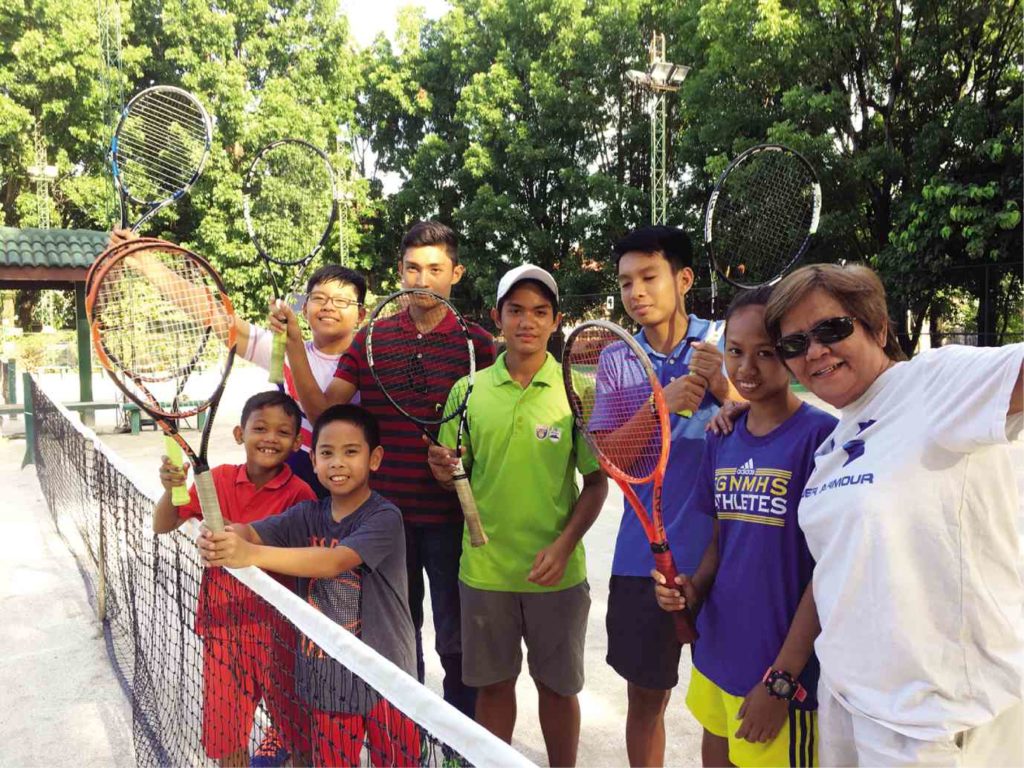
Marissa Sanchez with her wards at Angeles City Tennis Club—Jed Labasano, Jayline Manganti, Andrei Torres, Zac Virtucio, Nathan Novilla, Matthew Tiotuico, and Jeremiah Labasano.
She still has the touch with her solid ground strokes, though slowed by the years. Now 60, former national tennis champion Marissa Sanchez simply won’t turn her back on the sport where she reigned as No. 1 for the better part of a decade from the mid-1970s.
At the Angeles City Tennis Club (ACTC) inside Villa Gloria Subdivision, Sanchez holds fort, training health buffs and proteges as young as seven years old.
“I love tennis, that’s why I train young people and invest time in them,” says Sanchez, who pleaded burnout and retired when she was in her early 30s to give way to the likes of longtime doubles partner Gladys Imperial, Dyan Castillejo and Pia Tamayo, the United States-trained champion.
Who could forget Sanchez, the tireless and aggressive Pampangueña who, in 1978, powered the national women’s team to a rare appearance in the main draw of the Federation Cup?
“Coach!” Jed Labasano calls out to her as she arrives for another training session at the ACTC. Ranked eighth nationally in the boys’ 16-and-under class and 16th in the 18-and-under, Labasano is just one of a few bright, young players under her tutelage.
“I’m proud of Jed,” Sanchez says of her 15-year-old ward whom she has trained since he was 10.
Not one to ignore talent when she spots them, Sanchez trains kids only when they are “able to hit a ball with authority and are hardworking, patient and disciplined,” like Jayline Manganti, a 15-year-old dusky ball girl.
Labasano and Manganti are just two of her wards at ACTC. The others are Andrei Torres and Zac Virtucio, both 17; Nathan Novilla, 12; Matthew Tiotuico, 9; and Jeremiah Labasano, 7.
Sanchez has lost track of the number of players she has handled after bowing out of competitive tennis three decades ago. She trained children of well-to-do families at Valle Verde in Pasig, as well as members of royal families when good pay lured her to the Middle East.
Despite winning over 100 trophies and medals in her heyday, she did not retire a wealthy woman. “Friends are my wealth,” she laughs.
Sanchez soared to fame when tennis was very much a male-dominated sport. Her career was painstakingly recorded by her late father, Modesto, in a thick album of notes, photos, published stories and even telegrams.
She learned tennis by tagging along with Modesto, a tennis enthusiast, when the ACTC was still in Angeles’ Barangay Pulong Bulo. Among the men who frequently played there were banker-writer Renato “Katoks” Tayag Sr. and tennis legend Felicisimo “Totoy” Ampon.
“She was just like my own shadow because wherever I went she was always behind me,” Modesto wrote in an essay, ‘Marissa in Action.’ “She stood where I fell; she continued where I failed,” he added, referring to Marissa’s meteoric rise after a sprain forced him out of the sport.
Her mother, Maternidad, a softball player, did not get in the way of her sixth child’s plans.
Sanchez started playing serious tennis when she was 12 so she could earn a scholarship at the old Holy Angel College. It did not take long for the young netter to bring home gold medals from tournaments organized by the Association of Private Schools and Colleges of Pampanga in 1969 and the Private Schools Athletic Association (Prisaa) in 1970.
It was during a match in Bohol province when she was spotted by a man she remembered only as “Mr. Bumanlag,” who asked her to join the Nueva Ecija Tennis Club.
A year after snatching the gold medal in the 1972 Prisaa at age 16, she sparked Philippine School of Business Administration (PSBA) to victory in the Palarong Pambansa. Continuing her winning streak, she ruled the national nonranking tournament in 1973.
The year 1975 saw Sanchez reach the top of women’s tennis as she won both the National Tennis Open and the Philta (Philippine Tennis Association) Open. She remembers her victory well in the 1976 Philippine Open where she brought home P20,000, a considerable amount at that time.
But it was in the Fed Cup, the women’s equivalent of the Davis Cup, where Sanchez gauged her skills playing against the world’s finest players. “It was very tough [playing in the Fed Cup],” she says. “I compensated by relying on my experience.”
In the country’s first foray into the Southeast Asia Games in Malaysia in 1977, Sanchez brought home the silver medal in the singles. As the national champion she also saw action in the Asian Games, battling well-trained players from Japan, South Korea and China.
Sanchez lays claim to being the first female champion of the Philippine Columbian Association Open, winning the tournament in 1981.
When she finally retired and returned to her hometown of Angeles, Sanchez was asked to help in the sports program of the city mayor, Edgardo Pamintuan, a longtime friend.
These days, Sanchez says she wished that the national and local governments would team up to develop a training program that will help the youth excel in international competitions.
“’Yan ang hinahanap (That’s what we are looking for),” she says. “We have so much talent in tennis. What we need is total support from the government.”

